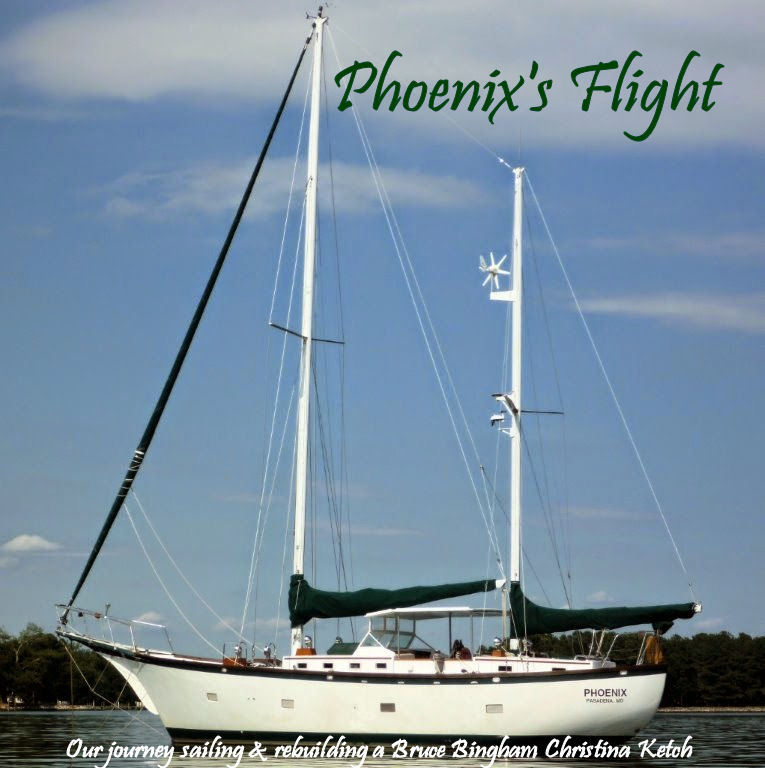Phoenix's forward hatch acts like a wind tunnel when we have it open at anchor! It's 26"x31" and typically provides enough airflow to dry clothes in the forward cabin faster than they line dry on deck! While we love our 4-way wind scoop in lighter air, we needed something a bit more substantial to handle squalls.
We've long admired Terry Sargent's Squall-Proof Wind Scoop design, so we decided to make one for Phoenix. Terry's design is featured in Jim Grant's The Complete Canvas Worker's Guide, and further modifications are mentioned on Terry's blog. Similar in concept to a dorade box, the scoop is essentially a baffled box that fits over your hatch to funnel air down below while keeping the rain on deck.
 |
| Terry Sargent's wind scoop design |
So with some online research we stumbled upon Aqua Gun -- a solution dyed polyester fabric (Sunbrella is solution dyed acrylic). Like acrylic, polyester fabrics are inherently water proof, and from everything we've learned to date, Aqua Gun's UV characteristics are on par with Sunbrella's. The fabric is slightly heavier in weight than marine grade Sunbrella (11oz versus 9.25oz), is 62.5" wide, but has an unfinished edge so you really have about 61" of working width. The draw backs are that it's currently only available from one supplier, and your choices are limited to three colors (blue, forest green, and tan). The HUGE plus, however, is that it's currently selling for $6.88/yard!
We called around to some different commercial canvas shops that are working with both materials to get their thoughts and those that we spoke with said that Aqua Gun was as durable as Sunbrella. At that price, we decided it was worth the experiment. All of our other exterior canvas is forest green so you'd think we'd buy that color, BUT, recent experience with the aft hatch dodger made us realize that on partly sunny days, that dark color gets pretty hot and can heat up the air on its way down below. So we opted for tan, in the hopes that it would be less inclined to blow hot air down the hatch.
Once the fabric arrived we were off to the races. Like Terry we went with a peaked roof for the wind scoop, though we added a few more attachment points and a second topping lift to help shape the scoop and to keep water from pooling on the top. We used 1" strips of heavy duty Velcro to secure the front and inner flaps, and used common sense fasteners to secure the scoop to the hatch base.
We had previously installed common sense studs to the hatch for our everyday hatch covers, so we followed the same pattern and installed the eyelets to the scoop where they aligned with studs on the hatch. With those in place, we did not need the weighted rod at the base of the hatch in Terry's picture above.
The original design called for fastening the lower part of the scoop to the toerails. This wasn't an option for us, and we're not big fans of grommets since they tend to rip out of fabric, we sewed webbing loops to the two endpoints. We ran lines forward to two cleats, and aft to the dorade guards to pull the lower forward edge down. We also sewed webbing loops to the sides of the scoop at the base of the inner flap, which were used to help tighten the flap base. An additional design modification was to add a bottom panel to the forward scoop. This addition helped funnel more air down the hatch compared to the original design.
 |
| Side view of the wind scoop We found that with a little finessing, you can pull the lines tight enough to remove the wrinkles seen here |
 |
| Back view, attached with common sense fasteners |
 |
| All flaps in place, ready for some serious weather! |
 |
| Front flap up with additional bottom panel for better air flow. |
 |
| Both flaps up for maximum air flow |
It rained most of the night and we had the forward hatch wide open. There was so much airflow it was almost chilly in the crew's quarters! I'll get a better shot the next time we use the wind scoop, but in the meantime, this one will have to do.
 |
| The squall-proof wind scoop in action! |
